Schweinfurt 1945.
On April 11, 1945, Schweinfurt was occupied by the American Rainbow Division. The war was over for the heavily destroyed ball bearing metropolis. In 2024, the Schweinfurt City Archives asked me to research films from the National Archives and screen them on the 80th anniversary of the end of the war. One viewer wanted access to the footage, which I am happy to provide via the links on Vimeo. Another viewer asked about responsibility for what had happened. Questions were also asked about the behavior of the invading American soldiers. Here are a few thoughts on that.
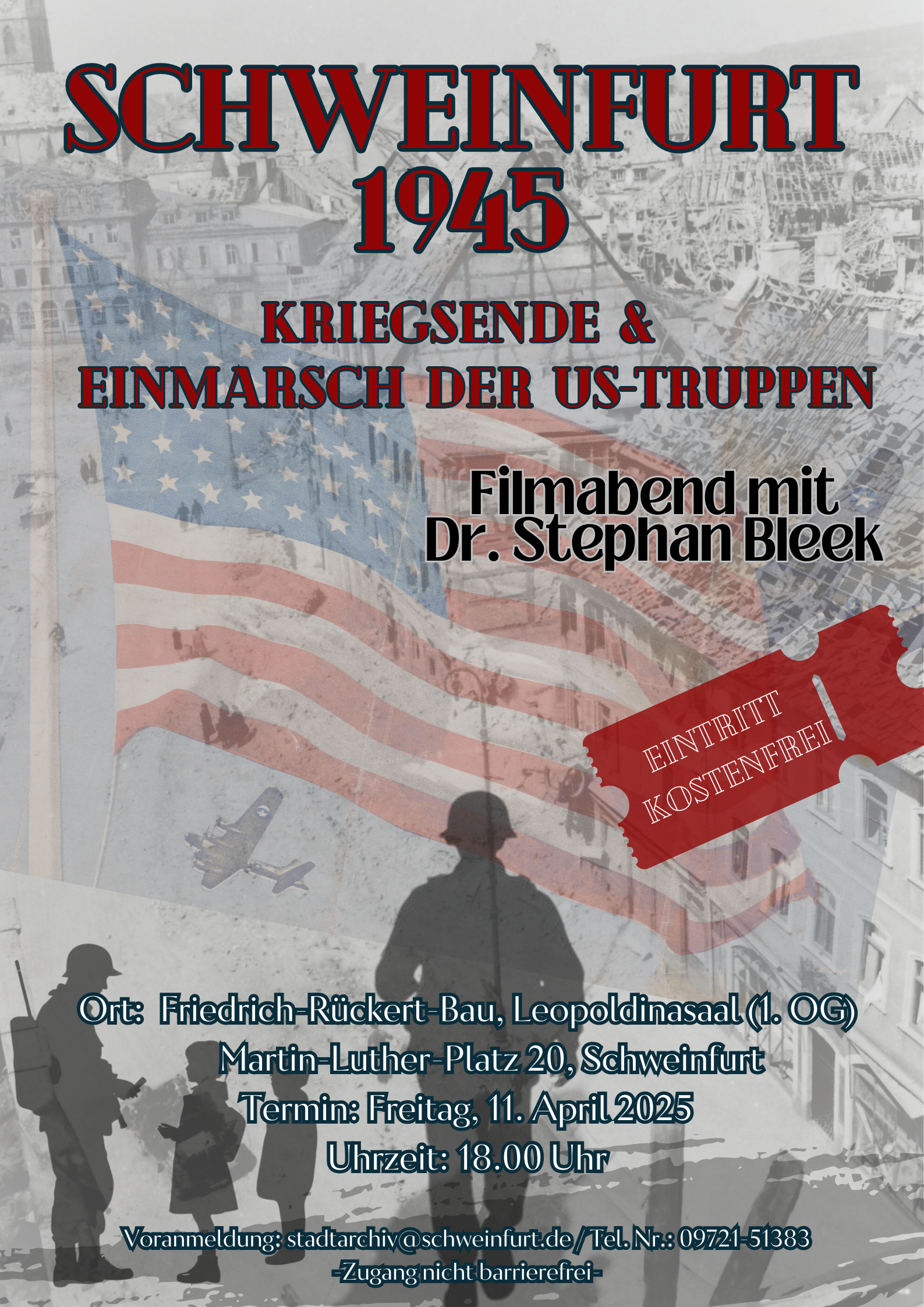
End of the war in Schweinfurt in 1945. Poster: Schweinfurt City Archives
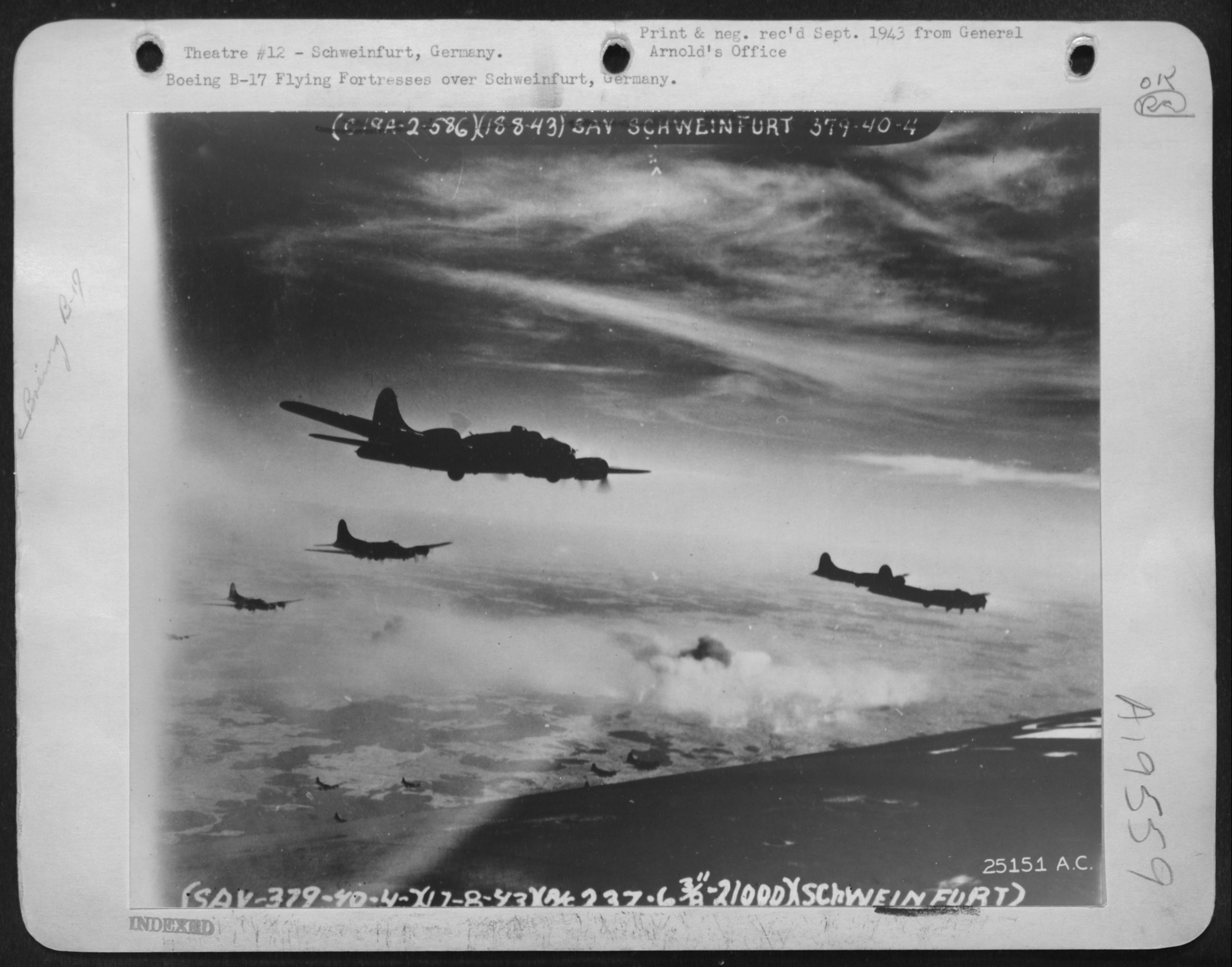
B17 “Flying Fortress” approaching Schweinfurt in 1943. Image: National Archives / Historiathek
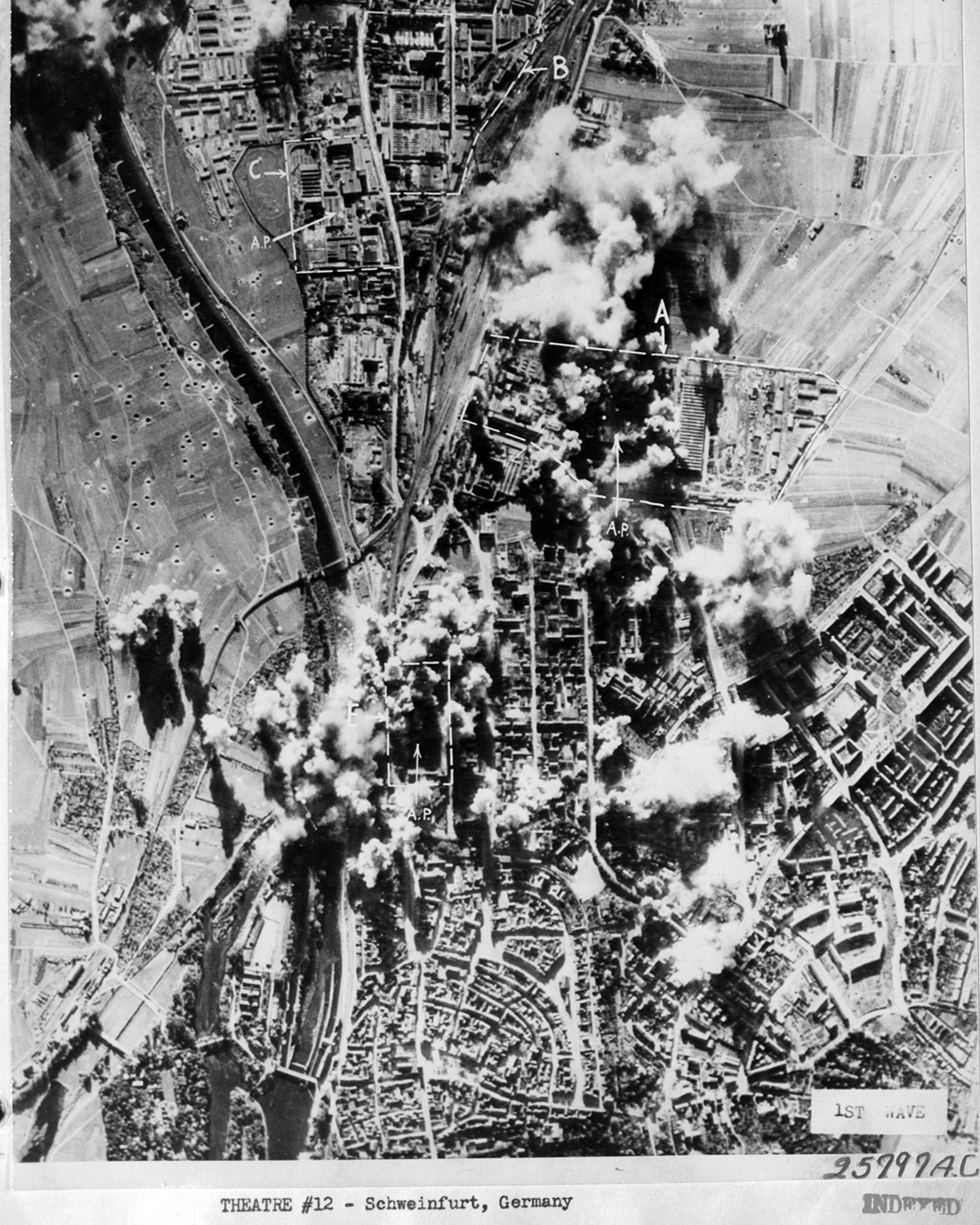
Bombing of Schweinfurt in 1943. Photo: USAF / National Archives
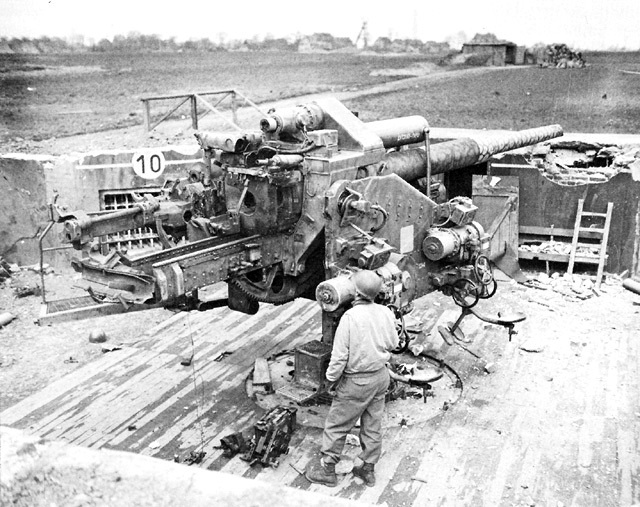
Flakgeschütz Schweinfurt 1945. Foto: National Archives

US tank near Schweinfurt – April 10, 1945. Photo: Historiathek / zb Media
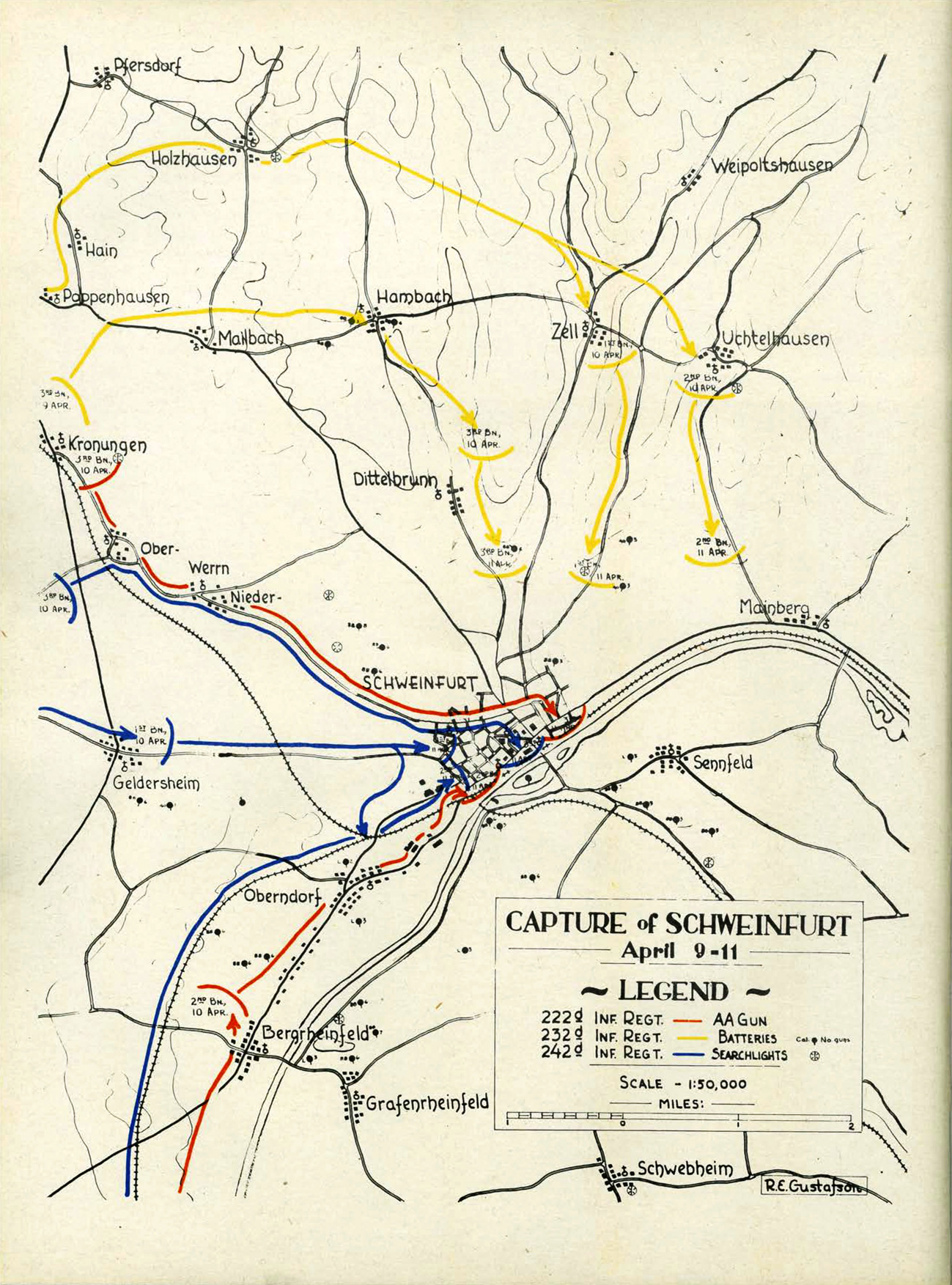
Advance of the Rainbow Division, April 1945. Photo: National Archives / Historiathek
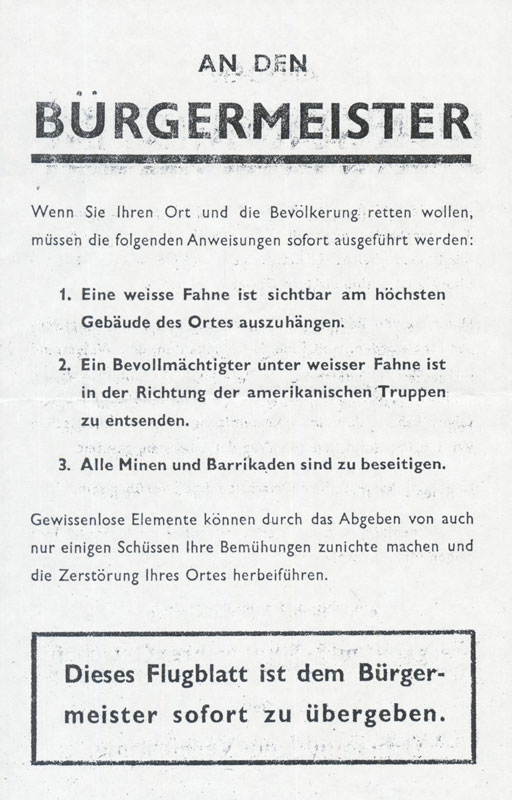
US leaflet calling for surrender, used in April 1945. Photo: National Archives
April 11, 2025 marked the 80th anniversary of the capture of Schweinfurt by the American 42nd Infantry Division, the “Rainbow Division.” The historical film footage shows not only the final combat operations at the end of the war, but also images of a city that had already been severely damaged by the devastating air raids of 1943 and 1944. Particularly impressive are the film sequences showing the heavily damaged industrial facilities of Kugelfischer, SKF, and Fichtel & Sachs—companies that played a central role in arms production during the war and therefore became preferred targets for Allied bombers.
Center of the ball bearing industry
My connection to Schweinfurt comes through my grandparents and my mother. My grandfather Hermann Barthel played a key role in establishing the Kugelfischer company until the end of 1938. Schweinfurt, as the center of the ball bearing industry, was a strategically important location. According to the strategists’ logic, without ball bearings, tanks, airplanes, and trucks cannot run; without ball bearings, modern war machinery cannot function. At the beginning of the war, around 45% of German ball bearing production was concentrated in the two large companies in Schweinfurt, the “Vereinigte Kugellagerfabriken” (VKF, owned by Svenska Kullagerfabriken SKF, since 1945 SKF Germany) and FAG Kugelfischer, the “Erste automatische Gußstahlkugelfabrik vorm. Friedrich Fischer oHG.”
The American high command was aware of this, and the idea arose that destroying the ball bearing factories in Schweinfurt would strike a blow to the heart of the German war machine.
At the end of 1941, the German Reich declared war on the United States, and in 1942, plans were drawn up for a strategic air war against Germany, with heavy bombers gradually being transferred to England. In 1943, the first attacks were flown against targets in France and on the German coast. In August and October 1943, the American 8th Air Force set its sights on Schweinfurt – a city located deep within German airspace. I started the film evening with a film that was intended to explain the reasoning behind the choice of targets for the attacks to the American public: “The Case of the Tremendous Trifle”.
Idea and reality
“The Case of the Tremendous Trifle” was written at the end of 1944, after the heavy air raids on Schweinfurt. The course of these bombings, especially the second attack on October 15, 1943, is presented in a justifying manner. This is because in both attacks, the American bomber formations, which did not yet have escort protection from long-range fighters, suffered very heavy losses. The film argues that the strategists’ goal of eliminating ball bearing production had been achieved. But this is not correct.
What did really happen?
On August 17, 1943, around 376 B-17 Flying Fortress bombers took off on a combined mission against the Messerschmitt aircraft factory in Regensburg and Schweinfurt. The idea was to confuse and overload German air defenses by attacking two separate targets. However, due to delays in takeoff and the gathering of the 376 B-17 aircraft over England, the bomber formations were unable to fly to their targets simultaneously as planned. After the German fighter defense had already taken action against the formation of 146 aircraft heading for Regensburg, shooting down 12 aircraft, it was able to concentrate again on the formation flying towards Schweinfurt. The strong anti-aircraft defenses around Schweinfurt also hit the attacking aircraft hard. Sixty bombers were shot down, 176 were severely damaged, and over 600 men were killed. The loss rate of destroyed or damaged aircraft was 31%, a level “at which it was hardly possible to sustain any further attacks,” sums up English historian Richard Overy.
During the first American attack in August 1943, the accuracy of the strikes was not very high. Of the 424 tons of bombs dropped, a large proportion did not hit the well-camouflaged factory buildings. Some of the bombs landed in open fields, others on residential buildings in the city. 140 civilians were killed. Production at the factories fell by 34%, but only for a few weeks.
“Black Thursday”
On October 14, 1943, later dubbed “Black Thursday,” the second attack on Schweinfurt took place. Once again, 229 B-17s flew deep into German airspace without adequate escort. Sixty-five aircraft were lost and another 138 were damaged—a total loss rate of 28%. The diary of American pilot Bud Clint, which was handed over to the city of Schweinfurt by his son Rob on October 15, 2025, provides a first-hand account of the attack. Clint’s aircraft, which he managed to fly back to England, had over 200 bullet holes.
The October attack hit the FAG Kugelfischer and SKF factories more precisely. Production briefly slumped again by around 35 to 40%, but after just a few weeks it was largely back up and running thanks to repairs and relocations in production.
Internal documents from FAG Kugelfischer that I have access to also make it clear why this was the case. Since 1934, the Luftwaffe had been pressuring the company to build halls for alternative production facilities so that production could be relocated away from Schweinfurt in the event of war. The concentration of production implied in the American film “Tremendous Trifle” still existed, but the division of roller bearing production had already been prepared and partially implemented in 1943. FAG Kugelfischer was able to continue production in Eltmann, Ebern, and other small towns in Franconia. SKF also had several alternative plants, including one near Berlin. There was also a well-concealed FAG stake in the ball bearing factory in Arbon, Switzerland, on Lake Constance, which, according to Hermann Barthel, was converted by his team of engineers in 1934 to FAG’s production methods and roller bearing types. Throughout the war years, the factory in Switzerland was able to supply the types of bearings required by the German arms industry without interference. After the attack, work began on constructing heavy bunkers at the FAG plant in Schweinfurt, which can be seen in another film from May 1945. Production also continued at these facilities until the city was occupied on April 11, 1945.
In addition, SKF was also able to supply the German arms industry on a large scale from Gothenburg. In 1944, the American government threatened neutral Sweden with bombing the SKF factories in Gothenburg in order to stop deliveries to Germany.
Another blow against Schweinfurt was carried out in February 1944 during “Big Week,” a week of bombing raids targeting the aviation industry. This American daytime raid was combined with a British night raid. The latter reduced the city center of Schweinfurt to rubble and ashes.
Anyone interested can read a detailed assessment of the impact of the many air raids in Richard Overy’s book, The Bombing War: Europe 1939–1945, London: 2013, or in Wesley Frank Craven / James Lea Cate (eds.), The Army Air Forces in World War II, Vol. II: Europe, Chicago 1951. The United States Strategic Bombing Survey of 1947 also concluded that the strategic objective of the attacks had not been achieved.
Given the high losses, a repeat of such attacks without fighter protection was out of the question. This conclusion is drawn in another USAF film from 1945. The long-range fighter P51 Mustang brought about a turning point for strategic bombers. It appeared on the European theater of war in early 1944.
The misconception about the collapse of the arms industry
This film argues that although the goal of eliminating ball bearing production was not achieved, the relocation of production increased transport distances and thus increased vulnerability to attacks on railway facilities, for example. From today’s perspective, historians who have conducted extensive research into the files are able to assess the actual impact of the bombing more accurately. But even in the spring of 1944, Norman Bottomley, deputy chief of the British Air Staff, noted: “Even if public morale is very low, social collapse can be postponed for a long time by a ruthless and determined party system and a gang of brutal Gestapo executioners and criminals.” (Quoted in Overy, The War of the Bombs, p. 514). After the initial shock, the effect of the heavy bombing on the morale of the civilian population was not rebellion, but apathy and depression, and ultimately a dull determination to persevere, to protect oneself collectively. The evacuation of the destroyed urban areas meant that countless families were “sent” to remote rural areas, which also made it more difficult to achieve the solidarity against the Nazi leadership that was theoretically conceivable. There was no significant political opposition. Supported by a relentless forced labor regime, German arms production even reached its peak for a short time in the second half of 1944, despite the countless bombings. Only the approaching front on the ground led to the collapse of the arms production system.
The conclusion of English historian Richard Overy, considered one of the leading experts on this subject, is: “The Schweinfurt missions demonstrate the limits of precision bombing in the context of total war and the resilience of industrial systems under threat.”
Schweinfurt on April 11, 1945
Black-and-white films shot by Signal Corps cameramen during the advance of the American Rainbow Division show places such as Gemünden, Münnerstadt, Güntersleben, and Thüngen, which were heavily damaged by fighting, as well as the areas west of Schweinfurt. The soldiers of the Rainbow Division occupied Schweinfurt on April 11, 1945. The footage shows the field of rubble that remained of Schweinfurt. I have also included footage showing the cameramen at their dangerous work.
The films show the overwhelming superiority of the American motorized units and document the futility of the isolated German resistance that remained. If shots were fired at the advancing tanks from a village, it was reduced to rubble, as can be seen in Gemünden or Münnerstadt. Where small groups of German soldiers surrendered without a fight, houses and farms remained largely undamaged. Around Schweinfurt, where Nazi district leader Weidling had called for a final battle and where 11 German soldiers who were ready to surrender were demonstratively hanged from trees outside the city, the remaining anti-aircraft guns were supposed to stop the US tanks. Fifteen-year-olds manned the guns, some of whom can be seen in the footage. American air superiority, which enabled low-flying aircraft to destroy such positions with gunfire and napalm, also rendered these ideas of a “final battle” meaningless, and the orders given seem criminal. A “honorable defeat even in a hopeless situation,” as demanded by the fanatical elements of the German military, SS, and party leadership, is ethically unjustifiable. It is a culpable decision that unnecessarily increases the number of war casualties. The last-minute execution of soldiers willing to surrender is criminal. In the Schweinfurt cemetery, you can visit the graves of a large number of child soldiers from the last draft; some of the survivors can be seen in the film. The senseless final battle was finally ended by Schweinfurt’s mayor, Pösl, himself a staunch Nazi, with a radio message. Shortly before, Nazi district leader Weidling had fled with his entourage of SS and Wehrmacht personnel across the Main Bridge and had the bridge blown up behind them.
The American film footage that has now been found does not adequately document the events surrounding the capture of the city on April 11. Most of the material is currently missing and can perhaps only be recovered through extensive research in the National Archives. The few recordings that have been tracked down so far show that there must have been much more footage, as they document different moments of the advance at widely separated locations in the city.
The behavior of American soldiers
During the discussion at one of the film evenings, questions were asked about the behavior of American soldiers toward the population, and toward women in particular. There is an informative source on this subject: the reports from the parishes of the Diocese of Würzburg, published by historian Verena von Wiczlinski on behalf of the Diocesan Archives of Würzburg. The reports emphasize that the destruction in individual rural communities during the last days of the war in Lower Franconia was caused by the militarily senseless shelling of advancing US troops from villages. With a few exceptions, the pastors also give a good account of the behavior of American soldiers. This can be read in the book “Kirche in Trümmern?” (Church in Ruins?) by Verena von Wiczlinski.
The destroyed city in color films
The US Army Signal Corps was responsible for documenting the war on film. Particularly noteworthy in this context is the Special Film Project (SFP), which was created for the US Air Force under the direction of renowned director William Wyler. Wyler, already a respected filmmaker in Hollywood, was commissioned to capture the air war against Germany in moving images. The documentaries produced by his team served not only to inform the US public, but also to analyze and evaluate military operations. For this reason, the National Archives hold a large collection of unedited film footage shot between May and July 1945, including several reels on Schweinfurt. While viewing the unpublished film reels, I was able to find previously lost aerial photographs that had been incorrectly catalogued under Berlin in 1945, but which show the factories and old town of Schweinfurt.
Hollywood at War – William Wyler
Willi Wyler, born on July 1, 1902, in Mulhouse, Alsace-Lorraine, was a German-American film director. In 1920, he began his career in New York at Universal Film, owned by his uncle, producer Carl Laemmle. Before World War II, he had already been nominated for four Oscars in the category of Best Director. In 1941, he shot the feature film “Mrs. Miniver” in England, which portrays the courageous wife of an English pilot during the summer months of 1940, the months of Dunkirk and the German air raids on England. He himself called his work a “pure propaganda film,” and Churchill thought the film was worth as much as 100 battleships. Wyler won the Oscar for this film in 1942.
After the attack on Pearl Harbor in December 1941, Wyler volunteered for military service. Talli, Wyler’s wife, remarked, “He couldn’t bear the thought of sitting on the sidelines.” Although he was exempt from conscription due to his age, he received a commission as a major in the Signal Corps in 1942. In this position, he headed a film production unit that documented the operations of the US Air Force.
In the spring of 1943, Wyler and his team arrived in England. He and his cameramen were already on board the planes during the first daytime bombing raids on targets in France and Germany. The first film portrays the crew of the “Memphis Belle,” a B-17 bomber, on a mission against Wilhelmshaven.
A sequel to this film was intended to document the effects of strategic bombing on Germany. That is why there are also shots showing Schweinfurt. The black-and-white footage of air battles in the films “Tremendous Trifle” and “Conquest by Air” shown above was shot in color by Wyler’s team and copied over to black and white.
The cameramen and their director experienced the brutal reality of the aircraft crews. One of his cameramen, Lieutenant Harold J. Tannenbaum, lost his life during filming. Wyler himself suffered permanent loss of hearing and sense of balance due to the noise and negative pressure during a flight in a B25 in April 1945 and was returned to the US for inpatient treatment. However, he returned to Germany in May 1945 to work on the sequel to “Thunderbolt.” There are numerous rolls of Wyler’s color film in the National Archives. They show battle scenes, destroyed cities, deserted streets, the faces of many people, the civilian population without homes.
War in films – the truth?
The use of film footage to document war events began during World War I. Twenty years later, weekly newsreels were the most effective means of reaching large groups of the population with moving images via cinemas. In the US, the importance of film propaganda was already apparent at the start of the war in late 1941 due to events in Europe. The isolationist stance that still prevailed in the Republican-dominated Senate in the summer of 1941 was overturned by the Japanese attack on Pearl Harbor.
Hollywood did not hesitate to put its talents and capacities at the service of the military. The U.S. Army Signal Corps was the most important military film and photo agency during World War II. Numerous Hollywood filmmakers, experienced photographers, and cameramen worked to document the war in all theaters of operation.
War films do not give us an “objective” picture of the reality of war. The purpose of the films that were released in cinemas was to motivate and mobilize the home population. The work of US filmmakers is similar to that of the so-called propaganda companies that supplied the German weekly newsreels. But there are major differences, which I cannot go into in detail here. Viewers should not be deceived by the degree of distortion of reality, especially in edited film material, even American film material. My father, who was a military doctor, told me how the young men who marched past his hospital tent, eager for action, often ended up on his operating table as bleeding bundles after only a few hours. Such images are hardly to be seen in hundreds of rolls of film footage. In one of the rolls from the advance on Schweinfurt, however, there is a mild case.
During World War II, documentaries were not only a means of education and reporting, but also a weapon, a vehicle for propaganda and a repository of memories. They influenced the course of the war and, even today, after the eyewitnesses have passed away, they continue to shape our long-term visual understanding of history. When I worked for Bavarian television in the 1980s, a cameraman, Henning Sieps, told me about his time as a young filmmaker in a Wehrmacht propaganda company. He described the rules for camera work: to elevate one’s own soldiers by filming them from below. German tanks were often shown moving from the bottom left to the top right—in the diagonal of hope from Christian iconography. Enemy soldiers were humiliated by being shown from above. When watching such films today, we must remain aware of the subtle methods used to influence the viewer.
The question of responsibility
Following my film lecture in Schweinfurt, the question of responsibility for the events was raised. On the whole, the question seems simple: the Third Reich and Italy declared war on the US on December 11, 1941, four days after the Japanese attack on Pearl Harbor and Japan’s subsequent declaration of war. In this respect, the leadership of the Nazi Reich is responsible for the consequences of the US entry into the war.
In a narrower sense, one can consider the responsibility of the Allies for the air war in World War II. The casualties among the German civilian population number in the hundreds of thousands. Schweinfurt was bombed 22 times, with the attacks claiming around 2,000 lives and injuring over a thousand among the city’s population of around 40,000.
When cities such as Warsaw, Coventry, Hamburg, and Schweinfurt disappeared under the carpet bombing of the air forces during World War II, not only military but also deeply moral questions arose: Was it permissible to bomb city centers with residential areas? Was the attack on densely populated urban areas a legitimate means of warfare—or already a crime?
From a legal perspective, the air raids on Schweinfurt and other German cities were in a gray area that was not clearly regulated by international law at the time.
War without clear rules
The Hague Convention of 1907, the central body of international law at that time, prohibited attacks on “undefended towns and villages.” But aerial warfare was still a thing of the future at that time—aircraft were considered reconnaissance tools, not strategic weapons. It was not until after the First World War that lawyers from the League of Nations attempted to create a set of rules in 1923 with the Hague Convention on Air Warfare.
This document clearly opposed attacks on the civilian population. But it never came into force. None of the major powers ratified it – neither Great Britain nor France, Germany, Italy, or the USA.
When war broke out in 1939, there were therefore no binding rules under international law governing aerial warfare. What constituted a “military target” was left to the interpretation of the warring parties. And this interpretation was soon exploited to the full: factories, power stations, railway stations – but soon also workers’ housing that was “part of the war economy” and, ultimately, entire city centers.
Carpet bombing or precision strike?
As shown in the first film, air war strategists regard bombing as a targeted intervention in the enemy’s arms production. However, what was waged was a total air war that devastated entire areas. This was often unintentional, as the precision of the bombers was particularly low at night. In 1939/40, the German Air Force destroyed the city centers of Warsaw, Rotterdam, and Coventry. In the case of Coventry and London’s East End, the aircraft crews miscalculated their navigation by many kilometers. The targets were supposed to be armaments factories and the London docks, but residential areas were destroyed instead. The British Royal Air Force responded in 1940 with area attacks on German cities. The British public’s willingness to accept such actions only arose after the firestorms in London and Coventry. The bombing of Hamburg was the first in a series of terrible events. On the night of July 27-28, 1943, the British Air Force flew an attack on residential areas east of the city center with more than 700 bombers. “Around 30,000 people lost their lives in the resulting firestorm. The exact total number of deaths in “Operation Gomorrah” can no longer be determined today, but it is estimated to be between 35,000 and 40,000.” (See: University of Hamburg.)
The US Air Force relied on “precise daytime attacks.” However, as with the first attack on Schweinfurt, bombs missed their targets, or in other cities, industrial facilities and residential areas were difficult to distinguish.
Schweinfurt thus symbolizes the dilemma: the ball bearing factories were considered legitimate military targets – and yet the bombs, especially during the RAF’s night raid in February 1944, hit the entire city, its residential areas, and its people. Hundreds of civilians died and thousands lost their homes. Strategically, little changed. Morally, however, these attacks left wounds that extend far beyond the rubble.
The presentation of the pilot’s diary at the event on October 15 is therefore a special sign of reconciliation.
A legal vacuum is closed
The topic of aerial warfare was not addressed at the Nuremberg Trials of 1945/46. The Allies declared the bombings to be “necessary measures of war.” No one was charged with aerial attacks on cities—neither on the German nor on the Allied side.
However, images of destroyed cities such as Warsaw, Rotterdam, Coventry, Hamburg, Dresden, Würzburg, and especially the atomic bombings of Hiroshima and Nagasaki sparked a debate about whether aerial warfare, as conducted in World War II, represented a crossing of the line from civilization to barbarism.
After 1945, the legal loophole was closed: the 1949 Geneva Convention and its 1977 Additional Protocols stipulated that attacks “whose primary purpose is to spread terror among the civilian population” are prohibited. This effectively outlawed the carpet bombing of cities – a belated lesson learned from World War II.
Warfare, moral judgment, and moral responsibility
Historians such as Richard Overy and A.C. Grayling emphasize that the bombing of cities such as Schweinfurt, Hamburg, Würzburg, and Dresden shows how fragile the line between “legitimate warfare” and “barbaric destruction” had become. In this respect, the memory of the air war serves as a warning. Technical superiority without moral restraint leads to barbaric destruction. The protection of civilians in war is not a sign of weakness, but rather the remnant of humanity and reason that must be upheld despite all hostility.
The responsibility of the German war effort, the political leadership around Hitler, Goebbels, Speer, and Göring, and the military leadership in the German Army Command must be judged similarly. At the latest since the defeat at Stalingrad and the Anglo-American advance in Africa in the winter of 1943, all those responsible on the German side knew that the war could no longer be won. Only a few commanders drew conclusions and were prepared to engage in resistance. According to their statements, this was out of moral distress. However, their reference to the oath they had sworn to Hitler in 1934 is an excuse. It does show, however, how few people, notably the circle around Colonel Stauffenberg, are able to muster the strength to make their own moral decisions in a modern large-scale apparatus such as the military.
Below the famous example of the officers of July 20, there are, however, numerous individual actions by soldiers or commanders who resisted or at least withdrew from criminal orders. This was also the case during the surrender of towns in April 1945, as seen in the film. In one scene, American and German medical officers treat a wounded German soldier. The situation further ahead is discussed using a map.
And the morality of criminal Nazi organizations such as the SS is a morality all its own. The morality of SS soldiers consisted of a complete reversal of human values. It replaced responsibility with obedience, conscience with orders, compassion with harshness. Philosophically speaking, SS morality was a radical reversal of the categorical imperative (Immanuel Kant): Not “Act so that the maxim of your action could become a universal law,” but rather: “Act so that you serve the destruction of the enemy, even if you have to give up your humanity to do so.” This is precisely what makes it reprehensible: it robs people of their humanity – and turns crime into a virtue. SS morality was not a failure of individual morality, but a deliberately constructed counter-model to the ethics of the Enlightenment. In this sense, it was not merely a moral failure, but a systematic program of demoralization. The Nazi regime embodies this program in all its facets.
The decision to continue the war despite the obvious defeat has been repeatedly described by historical research as an irresponsible act. Hans Mommsen speaks of a “self-paralysis of the general staff” that supported the criminal regime. Andreas Hillgruber analyzed the attitude of the Wehrmacht leadership as a mixture of “duty, loyalty to the state, and denial of reality.” Joachim Fest aptly called it a “perverse continuation of obedience that abandoned reason and humanity.”
The continued waging of a war that was recognized as hopeless represented a breach of every humanitarian and rational responsibility. It was an expression of a concept of duty that had become detached from moral judgment—and thus a moral and political blunder of historic proportions.
Perpetrators, accomplices, copycats
The important debate on the subject of the Nazi era in Schweinfurt is currently beginning again. The Schweinfurt City Archives has published a book on this topic: Perpetrators, Helpers, Free Riders, which brings together important essays on the subject. More information here.
Information sought: Please contact me
The Schweinfurt City Archives and I am looking for further information on this topic and, beyond that, on the Nazi era and the history of FAG Kugelfischer from its beginnings until 1940.
If you have any documents or information, especially about Hermann Barthel, please contact us! You can do so via the city archives or directly here. Please contact me here or write to info |at| stephanbleek.de.

Leave A Comment